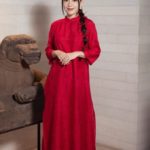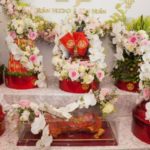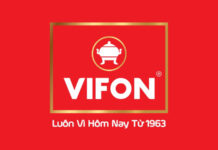Vietnam has a rich cultural heritage, and its wedding traditions are no exception. Today, we’ll explore the unique customs and rituals that surround Vietnamese nuptials, providing a glimpse into this special occasion.
Typically, wedding customs in Vietnam vary across regions, but they share some common features, including three main ceremonies: the engagement ceremony, the wedding proposal, and the wedding ceremony.
1 Engagement Ceremony
One of the most important rituals, the engagement ceremony marks the first official meeting between the groom’s and bride’s families. The groom’s family must choose an auspicious date and inform the bride’s family of their visit. With the bride’s family’s approval, the engagement ceremony can proceed smoothly, setting the stage for the couple’s future together.
 Engagement Ceremony
Engagement Ceremony
During this initial meeting, the two families discuss and agree on the wedding date, exchange gifts, and plan the upcoming ceremonies, ensuring a harmonious and well-organized celebration.
The gifts presented during the engagement ceremony are usually simple and symbolic, including betel leaves, areca nuts, tea, and cigarettes, all in even numbers, allowing the bride’s family to pay respect to their ancestors.
Engagement Ceremony Process
Participants: The engagement ceremony is an intimate affair, involving the bride and groom, their parents, and their siblings.
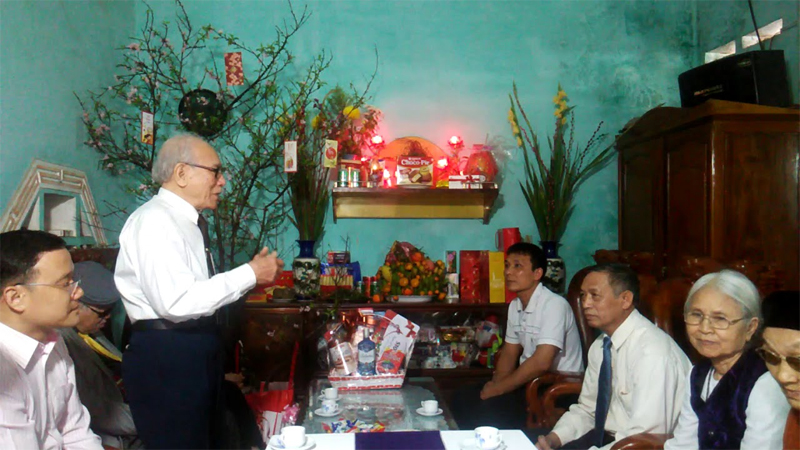 Engagement Ceremony
Engagement Ceremony
The ceremony begins with the bride’s family welcoming the groom’s family, offering refreshments such as tea, cigarettes, and snacks. The groom’s family then presents their gifts, which the bride’s family accepts and offers to their ancestors at the family altar.
Following this, the families discuss and choose an auspicious date for the wedding proposal and wedding ceremony, ensuring that all preparations are made according to tradition.
After the engagement ceremony, the bride is considered officially engaged.
Engagement Gifts
The engagement gifts vary across regions in Vietnam, reflecting local customs:
- Northern Vietnam: The engagement gifts typically include a pair of wine and tea, betel leaves and areca nuts, and cakes or fruits, all presented in even numbers to symbolize the union of the couple.
- Central Vietnam: The engagement gifts consist of a tray of betel leaves and areca nuts, a bottle of wine wrapped in red paper, and local specialties such as Hong cakes from Phu Yen and Binh Dinh provinces.
- Southern Vietnam: The engagement gifts in the south include a pair of wedding cakes, wine, tea, a tray of fruits, and betel leaves with phoenix-shaped areca nuts, a symbol of love and fidelity.
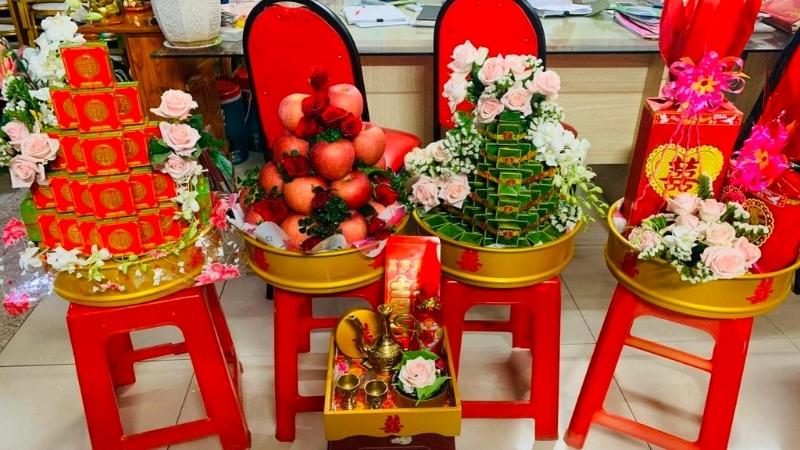 Engagement Gifts
Engagement Gifts
2 Wedding Proposal
The wedding proposal ceremony formally announces the engagement between the couple to their extended families and seeks the blessing of their ancestors.
During this ceremony, the groom’s family brings gifts to the bride’s family, including 30 betel leaves and trays of proposal gifts.
The groom’s mother presents the 30 betel leaves, each set of 10 leaves symbolizing a different ritual: the first set for the proposal, the second for seeking permission to marry, and the third for the presentation of gifts.
The bride’s family then accepts the proposal trays, which typically contain an odd number of trays (5, 7, 9, or 11), with the gifts inside being a multiple of two. Common gifts include steamed glutinous rice, roast pig, sweet cakes, tea, betel leaves, and cigarettes, or additional delicacies like xoi (sticky rice) and heo quay (roast pig).
Wedding Proposal Process
 Wedding Proposal
Wedding Proposal
The bride’s family takes a small portion of the food offered and presents it, along with the betel leaves, to their ancestors at the family altar. They then return two portions of the food to the groom’s family, keeping the rest for themselves.
The ceremony concludes with the bride and groom serving tea and betel leaves to the guests, marking their introduction to both families.
The interval between the wedding proposal and the wedding ceremony depends on the chosen auspicious date agreed upon by both families.
Wedding Proposal Gifts
The number of trays presented during the wedding proposal varies by region, with northern families typically offering an odd number of trays (3, 5, 7, or 9), while southern families offer an even number (4, 6, 8, or 10).
However, across all regions, the proposal gifts usually include: a tray of betel leaves and areca nuts, wine, tea, cigarettes, sweet cakes, fruits, lotus seeds, steamed glutinous rice, and roast pig, among other delicacies. Specifically:
- 5 trays: Wine, betel leaves, cigarettes, fruits, tea, and sweet cakes (such as bánh cốm, or steamed sticky rice cakes).
- 7 trays: Wine, betel leaves, cigarettes, fruits, tea, sweet cakes, wedding cakes, and lotus seeds.
- 9 trays: Wine, betel leaves, cigarettes, sweet cakes, tea, wedding cakes, lotus seeds, steamed glutinous rice, and roast pig.
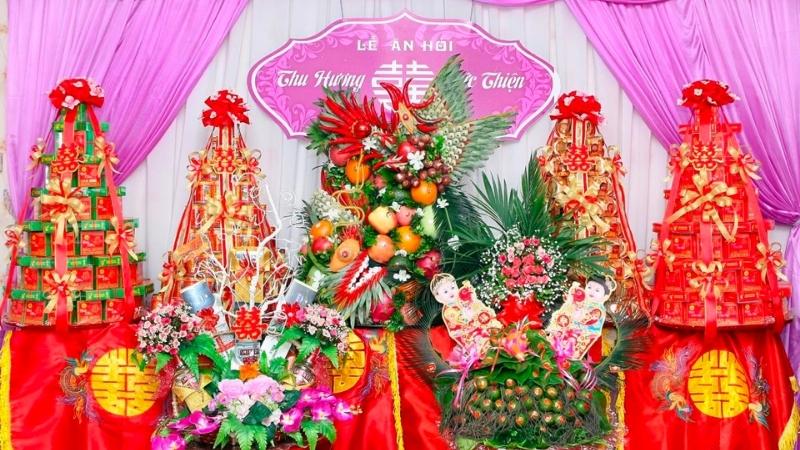 Wedding Proposal Gifts
Wedding Proposal Gifts
3 Wedding Ceremony (Marriage Ceremony)
The wedding ceremony is a grand affair, bringing together the couple’s families and friends to celebrate their union.
The bride’s family usually hosts a celebration one day before the wedding, with the bride and groom in attendance, and serves savory dishes to the guests.
 Wedding Ceremony
Wedding Ceremony
The groom’s family may choose to hold the ceremony at their home, a restaurant, or a hotel. If held at home, both families must plan and coordinate the rituals, including the bride retrieval, ancestor worship, introductions, and a photo session.
Wedding Ceremony Process at the Groom’s Home
 Wedding Car
Wedding Car
On the chosen auspicious date and time, the groom, accompanied by his family members, arrives at the bride’s home in a wedding car adorned with flowers. The bride, dressed in a gorgeous wedding gown, and the groom, in a sleek suit, prepare for the rituals ahead.
Vu Quy Ceremony at the Bride’s Home
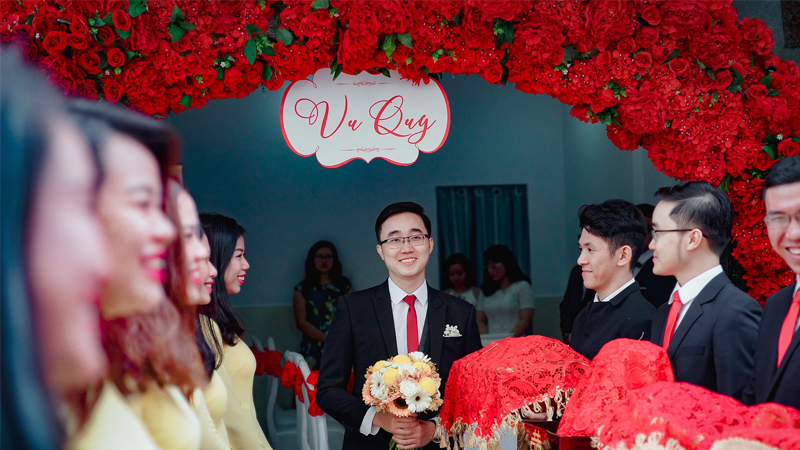 Vu Quy Ceremony
Vu Quy Ceremony
The groom’s family introduces themselves to the bride’s family and presents betel leaves as a symbol of their request to take the bride home. With the bride’s family’s permission, the groom is allowed to enter the bride’s room and escort her to the wedding car.
The couple then performs the ancestor worship ritual at the bride’s home and seeks permission to depart for the groom’s home, where they will perform similar rituals.
Wedding Ceremony at the Groom’s Home
Upon arriving at the groom’s home, the couple pays respect to the groom’s ancestors by burning incense at the family altar.
The groom’s representative then delivers a speech, after which the couple greets the groom’s mother and other guests. The groom presents gifts to his new mother-in-law, and the celebration continues with a feast and entertainment.
 Wedding Ceremony
Wedding Ceremony
For more information:
Wedding Ceremony Process at a Hotel
Both families arrive at the hotel 30 minutes before the guests to prepare. The bride gets ready in a separate room, and family members ensure their attire is perfect, and the gifts are ready. The couple then greets the guests as they arrive, accompanied by their parents.
A master of ceremonies, chosen by the families or provided by the hotel, introduces the couple and their families to the guests. A toast is made, and the couple visits each table to offer a drink and chat with the guests.
As the guests depart, the couple and their parents thank them at the hotel entrance, marking the end of the celebration.
4 Wedding Customs Across Vietnam’s Regions
Wedding Customs in Southern Vietnam
Engagement Ceremony
 Engagement Ceremony
Engagement Ceremony
If the families live far apart, the engagement ceremony may be skipped, and the wedding proposal and bride retrieval are combined into a single event. The engagement ceremony is attended by the couple’s parents, uncles, aunts, and other respected family members.
Wedding Proposal
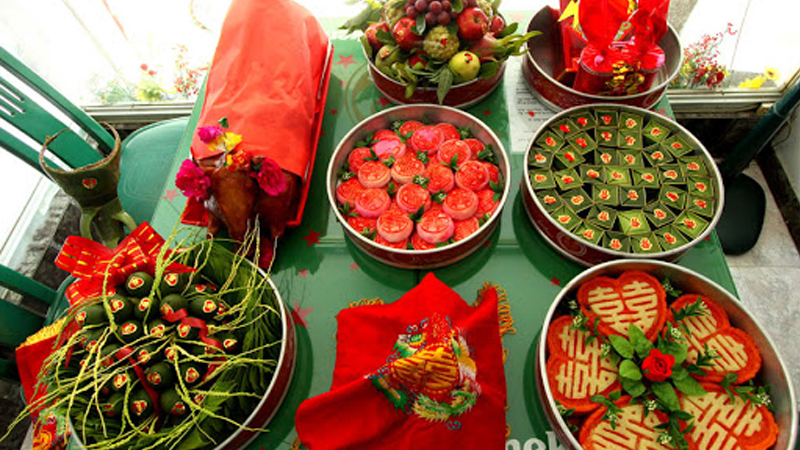 Wedding Proposal Gifts
Wedding Proposal Gifts
When the groom’s family arrives at the bride’s home, the groom’s paternal uncle carries a tray with betel leaves, a pair of lamps, and wine, accompanied by an even number of family members.
The gifts include a tray of betel leaves with an odd number of areca nuts, a tray of tea and wine, a tray of roasted pig, and various fruits and sticky rice.
The groom’s family offers tea, wine, and betel leaves to the bride’s family and discusses the wedding details. They also present jewelry to the bride as a symbol of their commitment.
Wedding Ceremony
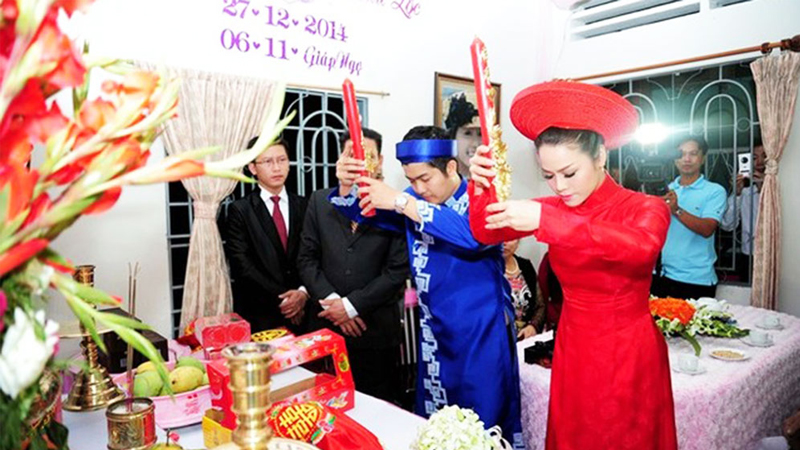 Couple Paying Respects to Ancestors
Couple Paying Respects to Ancestors
“Lighting the Lamps” is the most important and sacred custom in southern Vietnamese weddings. This ritual symbolizes the couple’s lifelong union and is performed by placing two large candles on the bride’s family altar. The bride and groom light the candles together, and the groom’s uncle opens a bottle of wine from the gifts and places it in the center of the altar. The couple then places the lamps close together, and the candles burn simultaneously. Superstition holds that if one candle burns higher than the other, the bride will dominate the marriage.
The bride retrieval is promptly organized once the guests have arrived. The best man pours wine for the groom’s uncle, who then announces the start of the wedding ceremony. The couple performs rituals before the family altar, pays respect to their parents, and celebrates with relatives and friends, capturing memorable photos along the way.
Wedding Customs in Central Vietnam
Engagement Ceremony


























